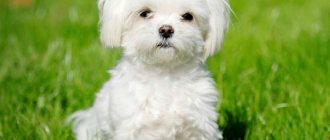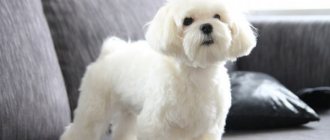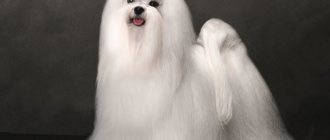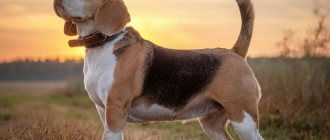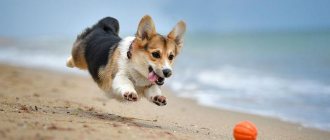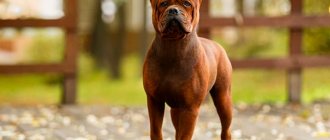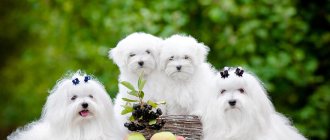Lapdogs are toy dogs that are now family pets and adore children. A pavilion with lap dogs at any dog show attracts the close attention of dog lovers. They are not only beautiful, but also smart. Representatives of the breed are frequent participants in circus performances. Kids with beady black eyes have a far from sofa-like past. They were in the royal service, fearlessly clearing the palaces of rodents.
Few lovers will be able to name all the subspecies of this breed. From the article you will learn what types of lap dogs exist, what kind of character the representatives of the breed group have, and what kind of family such a pet would be suitable for.
History of the breed
The history of the origin of the lapdog breed is full of hypotheses and inconsistencies. One thing is clear: more than two thousand years ago, Egyptian cave paintings introduced the world to dogs that were so strikingly similar to modern lapdogs. The first officially recognized variety can be considered the Maltese or Maltese. Moreover, the breed owes its name to geographical confusion.
The original name of the dog breed is Melita. It was given in honor of the name of the island of Meleda, on which the first individuals appeared. The island was located in the Adriatic Sea. But it had a geographical “twin” bearing the same name - modern Malta. The times in question were so long ago that no one cared that these were two different islands. They forgot about the mistake and then began to call the dogs Maltese, completely losing sight of the fact that the birthplace of the breed is another island.
There is also no reliable information about exactly how the lapdogs got to the Adriatic coast. One of the popular versions is Chinese. Its supporters claim that the ancestor of dogs is the Tibetan terrier and they came to Europe along the Silk Road. A more plausible version seems to be the Swiss origin of the breed and the relationship of lapdogs with Spitz-type dogs bred by the inhabitants of the Alps.
Some cynologists are trying to introduce Maltese poodles living on the Adriatic coast into the history of origin, but this version seems to be the strangest - the breeds have practically nothing in common. The exception is a sharp mind.
The breed flourished in the Middle Ages. Not only common people, but also representatives of the aristocracy paid attention to dogs. They took root in Italy and France. The fashion for dogs reached England only in the 16th century, and the first representative of the breed was presented to Mary Stuart. But the dog was so unpresentable in appearance that it was given to a “dog handler.” He liked the appearance and friendliness of the dog so much that the future breeder decided to breed a new variety - the English one.
The First and Second World Wars threatened the existence of the breed - people had no time for animals. But lovers managed to save their pets in difficult times. In the 30s of the last century, the first club was created, the standard was described, and club breeding of purebred dogs began.
Interesting: the first lapdogs appeared on Russian territory during the war with Napoleon. The retreating units lost their four-legged pets, who found homes in their new homeland. Crossbreeding with other breeds took place here, which led to the emergence of a new variety - Russian.
Description and characteristics of the breed
The little dog has such a touching appearance that the name “lapdog” seems somewhat rude for it. A more suitable name for the breed would be with an endearing suffix - “lapdog”. This is what best reflects the appearance and character of the dog.
When describing the breed, we can highlight the main points that future owners of lap dogs should take into account:
- These are friendly and sociable dogs that need constant contact with the owner;
- aggression is minimal - only to protect oneself or the owner;
- They have a sharp mind, which is combined with natural laziness. To raise a dog, you have to work hard;
- they choose one owner in the family, but masterfully adapt to the temperament of each member;
- picky eaters. They love goodies and often suffer from obesity;
- communication skills at a high level, they love to bark;
- get along with children of different ages;
- find a common language with other pets;
- They do not tolerate loneliness well and are capable of turning the house upside down if no one is home for a long time.
Important: despite their long (often curly) coat, lapdogs are hypoallergenic breeds. You can safely get a mini dog for a family in which one of the members suffers from allergies.
What does a lapdog look like - breed standard
The lapdog is a small dog. There is a general standard for group representatives:
- height at withers from 22 to 37 cm;
- weight from 2.5 to 6 kg;
- round small head;
- square muzzle;
- beady eyes black or brown;
- bite - “pincers”;
- teeth - small and even;
- nose - black;
- lips - dry with a black border;
- neck - medium length, does not form folds;
- back - medium length, straight;
- chest - voluminous, a little "wheel";
- paws - strong bones, but no developed muscles;
- claws and pads are dark in color;
- The coat is long, straight or curly. Its appearance and color differ and depend on the type of lapdog;
- color - all shades of white, colors with spots of black are acceptable. A black lap dog cannot be purebred. Fans of these dogs especially appreciate individuals with a snow-white color.
Dwarf Maltese
The dog, which appeared as a subtype of the American Standard Maltese, is not recognized, is not allowed to show, but is popular. These pets are very small (weigh up to 2.5 kg) and cute. The “baby face” look with large eyes and a short, upturned muzzle is popular.
Such changes in appearance are a defect of the breed; puppies with abnormal skull structure should be discarded. But enterprising breeders considered this a successful marketing ploy. Animals with similar defects (short muzzle, underweight, small size) often get sick and injured.
In general, doggies are no different from their “big” brothers: white straight hair, black eyes, perky disposition, affection. They also make good companions and family pets. The average cost of puppies is 25,000 rubles.
Character of the lap dog
The lapdog has a unique character. A representative of any variety can be called an incorrigible optimist. They are always active, cheerful and friendly. They are absolutely not vindictive and do not know how to take offense. These are very open, simple-minded animals.
The only thing that can put a dog into a state of depression and force him to commit an act of hooliganism is loneliness and boredom. In this state, this little pet can do a lot of things. Your favorite things, carelessly left in his field of vision, will be chewed. A patient and smart dog can make a puddle. All these are manifestations of the fact that the baby is bored alone.
Of course, lap dogs have their downsides, like any living creature. This is jealousy. If you have more than one pet in your home, be careful to ensure that everyone gets the same amount of affection and play. It is even worth distinguishing the lapdog from other favorites, since there is hardly another, more jealous creature than it.
Representatives of the breed are wary of strangers crossing the threshold of your home. The dog will bark at the stranger until he leaves the walls of the house or apartment.
Dogs love children and fun games. But you should be careful - too close contact can lead to bites. If you decide to get a lap dog, you need to teach your child the rules of playing with the animal and supervise joint games at all times. This is a general rule - even a small hamster can harm a child if he hugs him too zealously.
All types of lap dogs
It is interesting that each country to which representatives of the breed came made their own changes to the phenotype of the animal. This is how new official breeds and mestizos appeared, not recognized by cynological associations.
Maltese (Maltese)
As already noted, the Maltese is the ancestor of all currently known varieties of the breed. No version of its origin has reliable evidence, so it is generally accepted that it appeared in France in the Middle Ages. Then the dogs migrated to Italy, Britain and the New World.
Aristocrats and European monarchs enjoyed keeping snow-white animals, competing in the grace and decoration of their pets. Dogs became such a valuable commodity that they were used as a universal currency in some regions.
There is an uncertain situation with the breed standard. It is officially established by three canine associations. But different countries prefer to focus on the standards of different associations. Russian breeders conduct their activities in accordance with the FCI standard. America and England are guided by the requirements of their own clubs. Naturally, representatives of the breed who come from different countries differ significantly in external characteristics.
Interesting: American lapdogs are much smaller, have shorter hair and a narrow muzzle compared to the FCI standard.
For our country, the breed standard requirements apply:
- maximum height 25 cm;
- weight no more than 4.5 kg;
- the nose and eyes are ocher in color, there is a dark rim-border;
- the ears are triangular, hanging, covered with dense hair;
- the neck is short;
- the head is round;
- tail - touches the back, curved;
- the coat is straight, about 20 cm long. It should be silky and without curl. Tows, tufts or tangles are not allowed;
- color - snow-white, white, ivory.
Within the breed there is a subspecies - the dwarf Maltese. Mini Maltese differ from standard ones in size and shortened muzzle. These dogs are more like puppies. The Dwarf Maltese does not meet the official standard, but it is very popular among those who want to own a dog of this breed.
The price of a Maltese is from 25 to 60 thousand.
Russian Tsvetnaya lap dog
The name speaks for itself - the breed was bred in our country. Poodles and Shih Tzus took part in the selection. Breeders fought for a long time with the RKF for recognition as an independent breed, and such a decision was made in 1960. But with international recognition the situation is different - there is no official decision yet, but negotiations with the IFF are underway.
If we talk about the appearance of the dog, its main difference from its fellow group members is the color of its coat. Acceptable colors:
- black;
- grey;
- the whole palette of brown.
At the same time, the standard does not allow white spots on the animal’s body. Externally, the Russian lapdog is very similar to a bichon, but with floppy ears. The maximum weight of the animal is 4 kg, and the average height is 24 cm.
The peculiarity of temperament is boundless courage. This animal barks for a reason; it is ready to fight with any opponent.
Cost - from 10 to 35 thousand rubles.
French lapdog (Bichon Frize)
The history of the origin of French lap dogs suggests that the original habitat of furry babies was the Canary Islands. Together with the sailors, the bichons set off on their journey, helping to get rid of rodents and brightening up the everyday life of the sea wolves with their games. Once on the European continent, the dogs quickly dispersed to different countries.
The result is a breed whose homeland is considered to be France. The external characteristics of the Bichon Frize are fully consistent with the Maltese standard. A distinctive feature is curly snow-white wool. This is how the word in the name of the breed is translated (“frise” - curly). But to say that a dog’s fur is simply curly is not enough. It is springy, as if the dog had just recently undergone a small, tight “chemotherapy”.
Interesting fact: the standard color is snow-white. A Bichon puppy may have red markings, but these will disappear as they age.
Price - from 30 to 100 thousand.
Italian lapdog (bolognese)
The breed comes from Italy (Bologna). It is known that the breed appeared in the country already in the 12th century. It was held by ordinary people, owners of large estates, doges and rulers.
Distinctive features of the Italian variety of the breed:
- the coat is curly. Unlike the Bichon Frize, she does not have a tight curl;
- locks of wavy fur hang freely, having extensions on the tail and head;
- the dog becomes like a shapeless ball, although the Bolognese’s body is always toned;
- color - white. Stains are not allowed.
Maximum height at the withers is 30 cm, weight no more than 5 kg.
The cost of a puppy is from 30 to 110 thousand rubles.
Havanese (Havanese)
The Havanese Bichon is native to the island of Cuba. It is the Havanese representatives of the breed that are particularly friendly. Interestingly, lap dogs, poodles and Cuban mongrels took part in the creation of the breed. The first ancestors of the breed appeared in the 18th century, and it received recognition in 1996.
The Havanese is a complete copy of the Bichon. The exception is the color, which was changed due to participation in the selection of Cuban yard dogs. There are brownish spots on the tips of the ears, head and body.
Cost - from 30 to 90 thousand rubles.
Coton de Tulear
The Madagascar lapdog came to the island after a French ship was shipwrecked off its shores. A distinctive feature is the dog’s fur, which in structure resembles cotton. This is reflected in the name of the breed (coton - cotton, Tuléar - the name of a port in Madagascar).
Madagascar Bichons have long, straight hair. The usual color is white, but fawn spots on the head are acceptable. The breed was officially recognized in 1970.
The cost of a puppy is from 40 to 90 thousand.
Small lion dog (levchen)
The breed causes a lot of controversy. There is an opinion that the Bichon Lyon has nothing in common with lapdogs. However, the breed is included in the group. Most likely, the breed was the result of crossing Epagnoles and Great Danes back in the 2nd century AD. Interestingly, there has never been much demand for levchens. Perhaps that is why they were included in the Guinness Book of Records as the rarest dog breed.
Appearance of small lion dogs:
- maximum height - 32 cm;
- wool - long fluffy;
- colors - black, piebald, brown, gray, red with white splashes.
The name somehow includes the word “lion” or its derivatives. This does not mean that the animal's fur grows like the mane of the king of beasts itself. To give the pet an external similarity, it will be necessary to trim it, removing almost the entire cover on the back of the body.
The breed has not been finalized, work is underway. The priority direction is a square head and body.
The cost of babies of this breed can reach up to 200,000 rubles.
Mixed breeds
Currently, a new trend is popular - designer dog breeding. His goal is to create fashionable dog breeds that will appeal to celebrities or rich people. As a result of this work, mestizos appear. These are dogs that combine the phenotype of two purebred individuals who took part in selection.
Miniature Schnauzer and lap dog
The result is cute dogs with the size of an average schnauzer and the coat of a lapdog. Most often, owners trim their pets according to the Schnauzer standard. From the lapdog, the hybrid has a cheerful disposition and friendliness, with a loud bark. From the schnauzer - courage and bravery.
Papillon and lapdog
The selection of the new breed was carried out consciously. In addition to these breeds, the Japanese Chin and Shih Tzu took part. The result is the Mi-Ki breed. The dog turned out to be cute and amazing. She retained her butterfly ears, small body and long fur.
Maltese and poodle
Maltipoo is already a fairly well-known hybrid. Pets of this designer breed can be seen among various celebrities. This dog is more like a plush toy because of its dense, delicate fur. Pets have a difficult character - they are very touchy and gentle.
All hybrids have a high cost. For example, a maltipoo costs about 200,000 rubles.
Price of puppies
You can buy a Maltese puppy in a specialized nursery or from a private breeder. The seller will provide the buyer with documents for the dog: pedigree, veterinary passport, etc.
It is not recommended to buy a Maltese puppy online or from other people, as the dog may not meet the breed standard and behave inappropriately.
The price for a purebred Maltese varies from 20 to 90 thousand rubles. If the puppy belongs to a litter of titled parents, its cost can be much higher. Defective individuals are sold much cheaper or given as a gift.
Maintenance and care of a lapdog
The lapdog is a breed exclusively for apartment keeping. In the house, the dog should have its own soft place, away from places with drafts, loud noises and temperature changes.
Small dogs have big minds. They will quickly and successfully master the indoor litter box. But any dog needs fresh air and socialization. Therefore, a two-time walk is recommended. In winter and autumn it is worth finding clothes for your dog. It will protect you from cold and dirt.
Special care will be required for the animal's fur. For exhibition animals, you will have to use the services of a groomer or master this art yourself. If the dog does not participate in exhibitions, coat care will be reduced to simple combing. Three times a week is enough.
Important: for combing you need a soft brush, no slicker brushes! Grooming your dog will make grooming easier. The fur is left only on the head. It grows for a long time, so you don’t have to cut the animal often.
Routine dental and ear hygiene is necessary. But your eyes should be examined after every walk, especially in the summer.
Tendency to diseases
Maltese live long - up to 16 years. This is only possible with high-quality dog care. Weak and sick dogs rarely live past 10 years.
Maltese dogs are prone to:
- pathologies of the organs of vision;
- problems with the gastrointestinal tract;
- allergic reactions;
- diabetes mellitus;
- cardiovascular diseases;
- dislocated knees.
Feeding
It is permissible to feed lapdogs both industrial food (not lower than premium) and natural food. In the second case, vitamin complexes will be needed so that the dog receives everything it needs for health.
Bolonki are gluttons and beggars. You should not follow a lead and feed your pet excessively or with food from the table. Obesity and allergies are faithful companions of the breed.
“Souring” of the eyes and excessive lacrimation are the first signal of flaws in the diet. With proper care, your pet will be with you from 12 to 17 years.
Health
Most maltese diseases are inherited, so once every six months the animal must be brought to the veterinary clinic for an examination. One of the characteristics of the breed is watery eyes. This problem is caused by long hair on the face, atypical eyelash growth, and obstruction of the nasolacrimal system.
Hereditary diseases of the Maltese:
- bronchial asthma;
- glaucoma;
- food allergies;
- diabetes;
- retinal atrophy.
Vaccination
Puppies are vaccinated at 8, 12 and 16 weeks against distemper, hepatitis, parvovirus, bordetellosis, and parainfluenza. 7-10 days before vaccination, deworming is carried out.
An adult animal is vaccinated annually against plague, hepatitis, rabies, leptospirosis, and parvovirosis.
Owner reviews
It is difficult to find negative reviews about this dog breed on the Internet.
Ilya K. Gave his wife her dream for her birthday - a Bichon Frize. I'm delighted with her. Very smart dogs, ready to play day and night. They ride well in the car. By the way, it’s better to always take it with you. Otherwise, he will scream, bark and cry at home. Our girl is already 11 years old, in good health and still as active as a puppy.
Irina O. We promised our child a dog a long time ago. Everyone couldn't decide on the breed. We bought a Russian colored one. I didn’t even know that there was such a thing, but we were visiting and there we saw this miracle. Baby, but very smart. The wool is so nice! My child (9 years old) and I are best friends. He puts up with a lot from his son, but I make sure that they don’t offend each other.
Interesting Facts:
- The snow-white coat of lapdogs is the result of careful inbreeding. Red and black representatives of the breed lived on Melita. But for breeders, white color was a priority, so only white dogs were allowed for selection;
- lap dogs practically do not shed;
- lapdogs are excellent healers. The breed is often used in canistherapy;
- The most expensive Maltese dog cost 15 thousand dollars.
Nutrition
It makes no sense to say that nutrition plays almost the leading role in the formation of canine immunity. Breeders at offline meetings and on the Internet loudly argue among themselves which is better - factory feed or natural products.
Black Russian lapdog puppies
And the owner and his pet solve this issue quietly and peacefully in their kitchen. In the end, this is a purely individual matter. Is it convenient for the owner to feed the dog dry food? Great. The main thing is to ensure that the food is of high quality, and also measure doses in accordance with the standards prescribed on the packaging. Vitamins and minerals are already included in the diet, so there is no need to worry about it further. In addition, the packaging is convenient to take on trips.
Do you have enough time for daily cooking? Also a great option, although more troublesome. But there will always be variety in the bowl. The dog will happily eat meat, sea fish, vegetables, fruits, cereals, and sour milk. The lapdog especially reveres quail eggs.
In both cases, it is important to provide the dog with drinking water by placing the bowl in a place accessible to the animal. Any owner of the breed should know that Russian lapdog puppies eat up to six times the first three months, and then one feeding is removed every month. By the age of one year, the dog eats twice a day, but does not remain hungry, because the amount of food in the plate has gradually increased.
The general rule for all breeders is not to feed the dog from your table, despite its sad and sad look. You should not give sweets, smoked foods, salty foods, potatoes, legumes, as well as foods that lead to gas formation.
Breeds similar to lapdogs
Dogs similar to lap dogs can be found in group 9 of the ICF collection “Companion Dogs and Toy Dogs.”
Affenpinscher
A German breed of dog that looks like a monkey. They are not very similar to lap dogs in appearance. It's all about the different fur of animals. But if you cut your pet's hair, you will see that the dogs' bodies and faces are very similar.
Papillon
A fragile dog with long silky fur. Outwardly, it is very similar to a Maltese. A distinctive feature is butterfly wings instead of ears.
Toy poodle
As already noted, there is a version that it was poodles that took part in the development of the Maltese as a breed. The small poodle closely resembles the Bichon Frize in its size and curly, plush coat.
Yorkshire Terrier
We are used to seeing these dogs with short hair. And if you let go of the Yorkie’s fur and let it grow to the paw pads, then in its appearance and coloring it will look like a Russian colored lapdog.
Lhasa apso
Lhasa Apso dogs are a Tibetan talisman that brings wealth and happiness to the owner. They are very similar in size and appearance to the Havanese Bichon. But the Tibetan breed has larger round eyes.
Dog training
The advantages of the Maltese dog include its ability to quickly learn commands. Already at 2 months, a dog can remember its name and begin to respond to its owner’s call.
Maltese often perform in the circus. They perform tricks of varying degrees of difficulty.
Sometimes there are stubborn dogs that don’t want to follow their owner’s commands. The way to solve the problem is early socialization of the pet.

